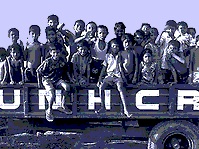
The United Nations High Commissioner for Refugees was established by the U.N. General Assembly in 1950, one of several attempts by the international community during the 20th century to provide protection and assistance to refugees. The League of Nations, the forerunner of the U.N., had named Norwegian scientist and explorer Fridtjof Nansen to the post of High Commissioner as early as 1921. World War II provided the impetus for several new organizations, the United Nations Relief and Rehabilitation Agency (UNRA), the International Refugee Organization and subsequently UNHCR.
The new agency was given a limited three-year mandate to help resettle 1.2 million European refugees left homeless by the global conflict. But as refugee crises mushroomed around the globe, its mandate was extended every five years. Today, UNHCR is one of the world's principal humanitarian agencies, its staff of more than 5,000 personnel helping 19.8 million people in more than 120 countries. During its half century of work, the agency provided assistance to at least 50 million people, earning two Nobel Peace Prizes in 1954 and 1981.
UNHCR's programmes, its protection and other policy guidelines, are approved by an Executive Committee of 61 member states which meets annually in Geneva. A second 'working group' or Standing Committee meets several times a year. The High Commissioner reports on the results of the agency's work annually to the U.N. General Assembly through the Economic and Social Council.
Created on ... september 29, 2003 by Pierre Ratcliffe